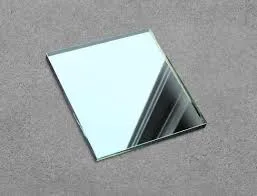

Reflective Float Glass A Modern Marvel in Architecture and Design
In the modern era, the significance of materials used in architecture and design cannot be overstated. Among these materials, reflective float glass has emerged as a pivotal element, transforming buildings' aesthetics and functionality. This specialized glass type combines the transparency of traditional glass with a reflective coating that enhances privacy, energy efficiency, and climate control.
What is Reflective Float Glass?
Reflective float glass is manufactured through a process called float glass production, where molten glass is floated on top of molten tin to create a flat, uniform sheet. Once the basic glass is formed, a reflective coating, usually comprised of metal oxides, is applied to one side of the glass. This coating serves multiple purposes, from providing a mirror-like quality to improving thermal insulation. The result is a highly efficient product that is visually appealing and functional.
Applications in Architecture
One of the primary applications of reflective float glass is in commercial buildings. Skyscrapers and corporate offices often use this glass to create stunning facades that capture the surrounding landscape while offering a sleek, modern appearance. The reflective surface not only enhances the building's aesthetics but also helps reduce the amount of heat absorbed, leading to lower energy consumption for cooling. This is particularly crucial in urban environments, where heat islands can exacerbate climate challenges.
Moreover, reflective float glass plays a vital role in residential architecture. Homeowners increasingly favor reflective glass for windows and doors due to its ability to provide natural light while minimizing visibility from the outside. This characteristic allows for increased privacy without sacrificing daylight, making it an ideal choice for urban homes or properties located close to neighboring buildings.
Environmental Benefits

The advent of reflective float glass has not only been a boon for aesthetics but also for environmental sustainability. By reflecting a significant portion of solar radiation, buildings clad in this material can maintain cooler indoor temperatures, thereby reducing reliance on air conditioning systems. This energy-efficient property is increasingly essential as the world strives to reduce its carbon footprint and combat climate change.
In addition, reflective float glass is fully recyclable, making it an eco-friendly choice compared to other building materials. This aligns with the growing trend in the construction industry toward sustainable building practices, where materials are chosen based on their lifecycle impacts and environmental footprints.
Challenges and Considerations
Despite its many advantages, reflective float glass is not without challenges. One major concern is glare, particularly in densely populated areas where buildings may obstruct sunlight. This can become a nuisance for pedestrians and nearby residents. However, advancements in technology have led to the development of coatings that mitigate glare while still maintaining the reflective properties desired in architectural applications.
Additionally, while reflective float glass can enhance energy efficiency, improper installation or selection can lead to unintended consequences, such as overheating in certain environments. Architects and builders must carefully consider the specific climate and orientation of a building to ensure optimal performance.
Conclusion
Reflective float glass represents a significant advancement in architectural materials, merging form and function. Its ability to provide aesthetic appeal, enhance energy efficiency, and offer privacy makes it a popular choice among architects and designers. As the demand for sustainable building solutions continues to grow, reflective float glass will undoubtedly play a crucial role in shaping the future of architecture.
With ongoing technological innovations, the possibilities for reflective float glass are expanding. As architects and designers explore new techniques and applications, this versatile material will contribute to creating healthier, more visually appealing, and environmentally friendly spaces. The fusion of modern design and sustainability exemplified by reflective float glass is a testament to the progress we can achieve when we prioritize innovation in our built environment.